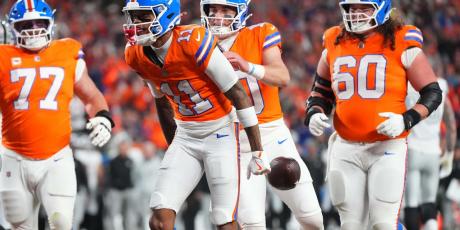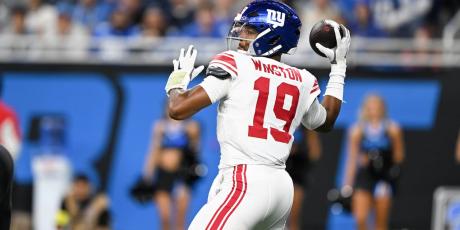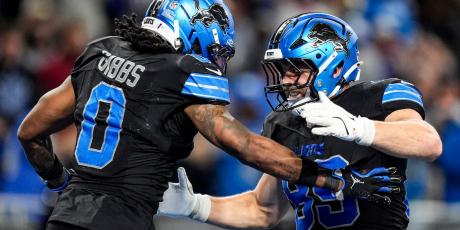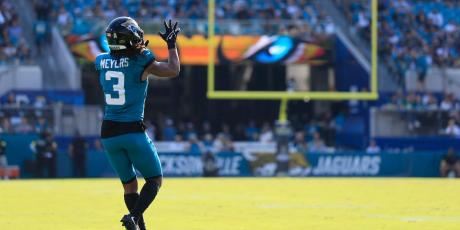What the Move to Philadelphia Means for LeGarrette Blount

On May 17, the Philadelphia Eagles signed LeGarrette Blount to a one-year contract. Blount is expected to fill the Ryan Mathews role for the Eagles.
Will Blount replicate the career year he had in 2016 with the New England Patriots?
Putting Blount's Remarkable 2016 Into Perspective
In 2016 Blount set a career-high in rushing yards, scored a league-leading 18 rushing touchdowns, and finished as the RB9 in PPR leagues with 232.9 fantasy points. While those numbers are impressive on the surface, they should actually give fantasy owners some pause.
Besides the fact that Blount didn’t have his first top-24 fantasy season until age 30, history tells us that a repeat of his performance is unlikely. Blount’s 18 rushing touchdowns were the most of any player in the league since Adrian Peterson in 2009. A staggering 46.4% of Blount's fantasy points came via touchdowns -- no other top-36 running back in the last five years has been as touchdown-dependent, and during that span only Jeremy Hill in 2015 saw at least 40% of his fantasy points come via trips to the end zone.
Blount put up touchdown volume that we almost never see in the current pass-happy era of football, but he was also scoring at a rate that will be difficult to keep up, scoring once every 17 touches last season. The league average for running backs over the last five seasons is one touchdown every 33.8 touches. Blount has been better than average for his career, but still required just over 24 touches per score.
If we extrapolate Blount’s career touchdown rate to his 2016 season, we see him fall to the PPR RB15 on the year, and a league average rate would have seen him finish as the RB22.
How Blount Fits In With Philly
As mentioned in the intro, Blount is expected to take over for Ryan Mathews in Doug Pederson’s offense. In 2016, Mathews saw 168 touches in 13 games, accounting for 36.4% of all team backfield touches, a touch share that ranked 32nd among running backs last season. Pederson seemingly wanted to use a backfield committee in his first season as the Eagles’ play caller, evidenced by a lone Philadelphia running back accounting for at least two-thirds of backfield touches in a game just twice.
The Eagles ran on just 40.1% of plays in neutral situations (score was within a touchdown either way), a rate which ranked 20th in the league. Once Philly got within scoring range, however, things changed. Philadelphia ranked in the top 10 in red zone rushing rate, keeping the ball on the ground on 64.6% of red zone plays. Inside the opponent’s 10-yard line, the Eagles ran on 79% of plays, the third-highest mark in the league. This run-heavy approach near the goal line led to Mathews seeing the sixth-most rush attempts in the league from within five yards of the goal line, despite missing three games.
The elephant in the room, of course, is the Eagles’ new focus on the passing game. Philadelphia has spent the offseason bolstering its receiving corps, and Carson Wentz is already one of the top candidates in the league for positive touchdown regression. Based on the starting field position of his red zone pass attempts, Wentz should have thrown roughly 18 red zone touchdowns, but he only had 13. With a year of experience in the league and improved outside weapons, Wentz should improve his red zone efficiency, which could cut into the goal line opportunities for Eagles running backs.
The Bottom Line
Blount is entering his age-31 season and finds himself on a team that is heavily invested in the receiving weapons that they’ve put in place around Wentz. Given that Pederson wants to get his running backs involved in the passing game, Blount will have a hard time approaching the 62% backfield touch share that he saw in New England last year.
The bright side for Blount is that there is touchdown upside on this team -- Philadelphia made it to the red zone on 32.4% of drives last season -- the ninth-highest rate in the league -- despite a rookie quarterback and mediocre receivers. If Wentz improves on his red zone efficiency, though, that could cap Blount’s touchdown ceiling in a spot where he is already expected to see a precipitous drop in his touchdown rate.
Expect Blount to shoulder most of the first- and second-down work, with a ceiling of somewhere between 10 and 12 touchdowns. If his ADP starts creeping into top-20 RB territory, I’ll have a tough time buying Blount in hopes of a running back on the wrong side of 30 replicating an outlying season.
Editor's Note: Subscribe now and get an early-bird discount on 4for4's 2017 Classic, Pro, or DFS products!
Related Articles
- Are the Eagles Ready to Soar with Alshon Jeffery and Torrey Smith?
- 2017 Initial Rankings: A Closer Look at Bilal Powell, Danny Woodhead, and Theo Riddick
- 23 Post-NFL Draft MFL10 ADP Risers & Fallers






















